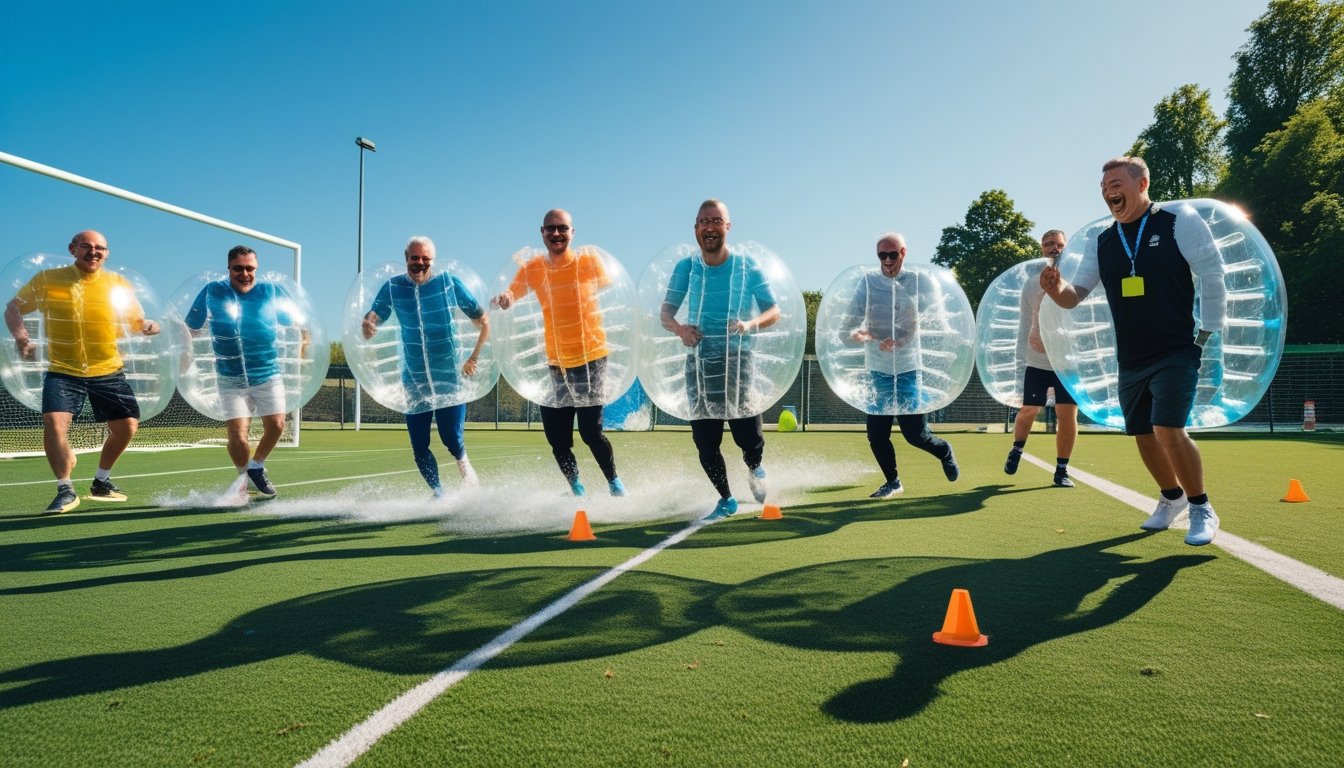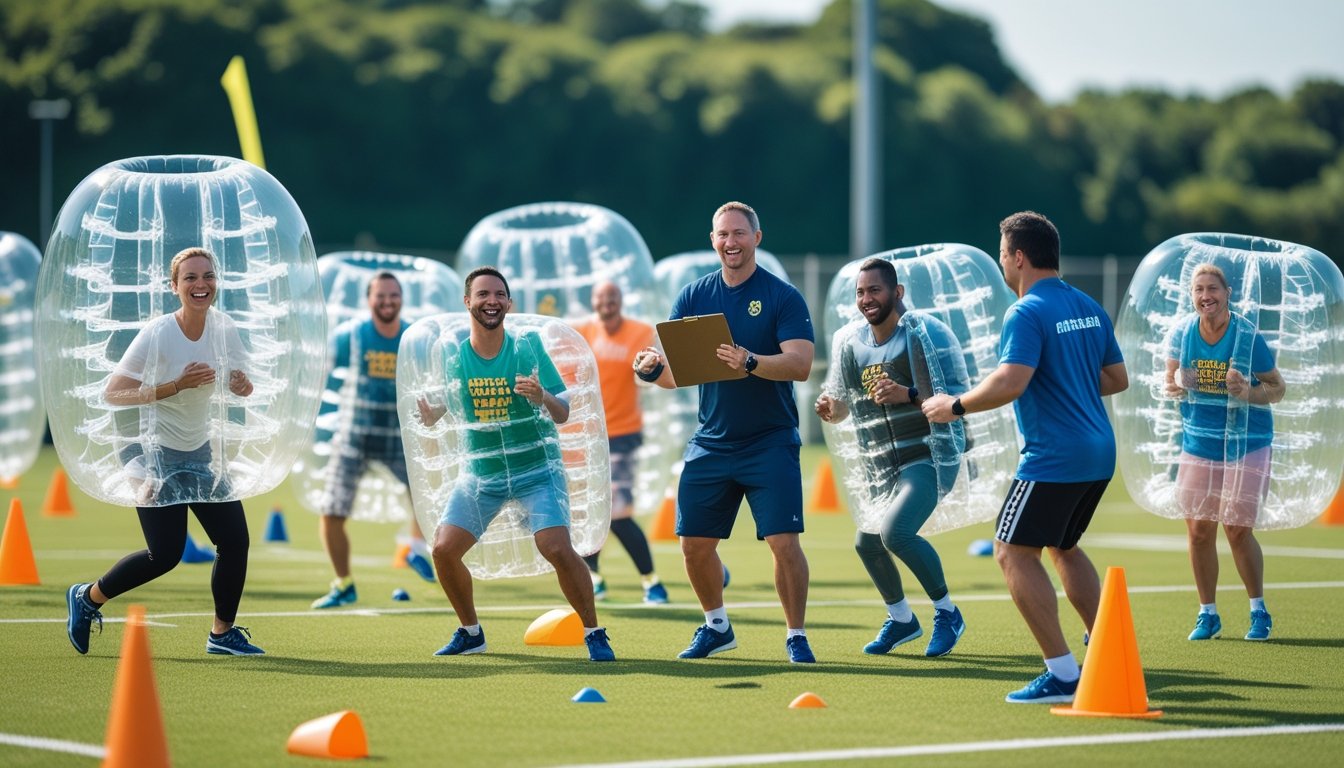Late updated: 19 Oct 2025 15:10
Written by: Emma Saunders
The Art Of Coaching Bubble Football: Key Strategies And Insights
Exploring the dynamic world of bubble football, we're reminded that traditional football skills and innovative strategies blend to create an exhilarating experience. Bubble football, a unique and entertaining twist on the classic sport, requires us to adapt our coaching techniques to focus on both skill development and fun. The art of coaching bubble football lies in balancing the fundamentals of the game with the novelty of playing inside inflatable bubbles. This combination challenges players to hone their agility, communication, and teamwork skills in an entirely new way.

By focusing on the essentials of bubble football coaching, we can unlock the potential for players to excel in this exciting arena. Creating strategies that incorporate safe play, coordination, and creativity is essential. As coaches, it's crucial to highlight the nuances of bubble movement and leverage it to enhance players' performance and enjoyment on the field.
Key Takeaways
- Bubble football combines traditional skills with innovative strategies.
- Coaching involves balancing fundamentals and the novelty of the sport.
- Success requires a focus on safety, coordination, and creativity.
Fundamentals Of Coaching Bubble Football

Coaching bubble football requires a distinct approach, combining traditional strategies with the unique aspects of the game. Our focus is on adapting familiar tactics and essential skills to enhance player development and performance in this playful yet competitive sport.
Key Principles In Bubble Football Coaching
Bubble football, or zorbing, challenges the conventional training routines of standard football. Balance and agility are pivotal due to the cumbersome bubble suits. Coaches must prioritise drills that improve players' stability and core strength.
Teamwork is also essential. We stress the importance of communication and coordination since the game's chaotic nature can often lead to isolation on the field. Coaches should create small-sided games to hone in on these collaborative skills. Tactical adaptability is necessary due to the game's fluid formation changes, adding a layer of complexity to coaching strategies.
Understanding 11v11 And 1 Back Formations
Bubble football's unique characteristics offer an opportunity to innovate with traditional football formations. The 11v11 formation demands a full field line-up, fostering comprehensive team strategies. In this setup, positioning and player roles need to be adapted to account for the suit's mobility limitations.
Incorporating a 1 back formation emphasises defensive solidity and quick transitions. This approach is exceptionally useful when players must quickly switch from offensive to defensive actions. Encouraging flexibility and awareness in these formations helps players better negotiate the transitions demanded by the bubble context, enhancing their tactical understanding and execution.
Essential Coaching Education And Online Resources
Staying informed about coaching techniques is crucial. Leveraging resources like an online library can provide coaches with access to innovative drills and strategies tailored to bubble football. Educational platforms offer a treasure trove of content designed to keep coaching methods current and effective.
The art of coaching this sport often lies in adaptation and resourcefulness. Coaching education that includes videos and practical demonstrations can be instrumental in developing successful coaching plans. By using a mix of theory and practice, we can ensure that our coaching remains both comprehensive and flexible, meeting the diverse needs of bubble football players.
Implementing Bubble Football Plays And Strategies
In bubble football, mastering specific plays and strategies can significantly enhance performance and enjoyment. With a focus on developing effective bubble screen plays, utilising a variety of passing tactics, and learning how to teach and install offensive plays, we aim to provide practical insights into building a robust play framework. We'll also explore the innovative approach taken by Highland Springs High School.
Developing Effective Bubble Screen Plays
The bubble screen play holds a pivotal role in bubble football due to its simplicity and effectiveness in spreading the field. To develop a successful bubble screen, the focus must be on timing and precision. The wide receiver must execute well-timed routes while the quarterback delivers the ball swiftly to exploit defensive gaps.
Good communication between players is vital. To optimise this play, blockers must work cohesively to clear paths and create space. Drill sessions should concentrate on the execution of blocks and routes, ensuring players understand their roles thoroughly. Incorporating variations such as fake runs can also keep defenses guessing and open up further opportunities downfield.
Utilising Passing Plays And Pass Play Types
Passing plays form the backbone of any offensive strategy in bubble football. When implementing these plays, we must consider the diversity of pass types available, such as quick passes and long throws. Quick passes can take advantage of defensive lapses, while longer throws may exploit mismatches in player speed and agility.
It's essential for the quarterback to assess the defence's positioning and adjust strategies accordingly. Employing play-action passes can effectively mislead defenders and create advantageous situations. Training sessions should emphasise the quarterback's decision-making process and the receivers' ability to adjust routes based on defensive setups.
Teaching Offence And Play Installation
The installation of offensive plays requires meticulous planning and execution. Each player must understand not just their position, but how they interact with teammates on the field. Start with simpler plays, gradually increasing complexity as the team's proficiency grows.
Using visual aids such as diagrams from resources like FirstDown PlayBook can enhance understanding. Repetition in practice solidifies comprehension and execution, while feedback helps adjust and refine strategies. By tailoring drills to focus on specific areas like timing and coordination, we can build a cohesive offensive unit ready to tackle varied defensive challenges.
Case Study: Highland Springs High School Approach
Highland Springs High School has found success by adopting an innovative approach to their bubble football strategy. Their emphasis is on flexibility and adaptability, allowing the team to counter different defensive strategies effectively. They focus significantly on situational drills that prepare players for real-game scenarios.
By integrating technology, such as video analysis, they identify areas of improvement and refine plays. Players receive personalised feedback, enhancing their understanding of the game plan. The school also places importance on the physical conditioning of its players, ensuring they maintain the strength and stamina needed to perform optimally throughout the game. This holistic approach has resulted in a more agile, responsive team on the field.
Frequently Asked Questions

In bubble football, several considerations come into play, from the necessary gear and distinct rules to optimal surfaces and strategic gameplay. Here, we address some common inquiries.
What essential equipment is needed to start playing bubble football?
To start bubble football, players need Zorb bubbles, which protect and encase the upper body, leaving them to kick freely. Standard football boots are recommended for proper grip, while comfortable sports attire is advised for flexibility and comfort.
How do the rules of bubble football differ from traditional football?
Bubble football offers a unique twist on traditional football. The primary difference lies in the aggressive use of the bubbles for bounces and hits. Though the objective remains scoring goals, gameplay is less structured, with no strict offside rule, adding to the fun and chaos.
Can bubble football be played on any type of pitch or is a specific surface required?
Bubble football can be played on a range of surfaces, including grass, artificial turf, and indoor pitches. However, a soft surface is ideal to absorb impacts and provide a safer environment for falls and collisions. Hard surfaces like concrete are not recommended.
What safety precautions should be taken when playing bubble football?
Safety is crucial in bubble football. Players should ensure Zorb bubbles are correctly inflated and securely worn. It's important to avoid collisions with excessive force to prevent injuries. Regular inspections of equipment help maintain a safe playing environment.
How are teams structured in bubble football, and is there a limit to the number of players?
Teams in bubble football usually consist of five players each, though variations exist. The smaller team size enhances mobility and control. Larger groups may rotate in and out to maintain energy and provide rest, ensuring all players have an opportunity to participate.
What are the most effective strategies for winning a game of bubble football?
Effective strategies in bubble football include maintaining balance and quick recovery after crashes. Utilising the bubble's momentum to block opponents and clear pathways can create advantageous openings. Team coordination and communication are key to manoeuvring effectively and scoring goals.
